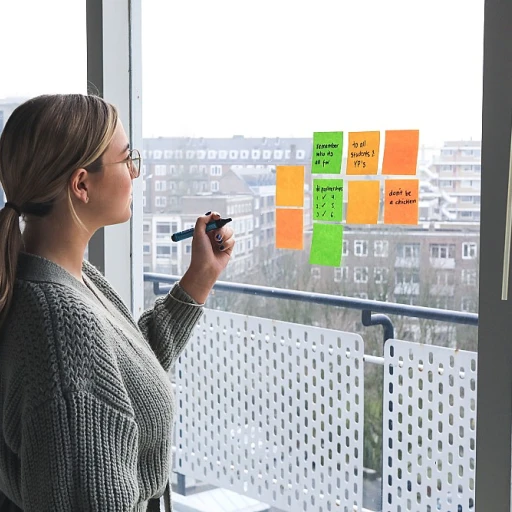Understanding the Importance of Feedback in Employee Retention
The Crucial Role of Feedback in Retaining Talent
Understanding the importance of feedback in the workplace is pivotal for fostering an engaged and committed team. Feedback is not merely a formality or a check-box activity; it’s a fundamental component of
empowering employees and enhancing their performance, thereby bolstering employee retention.
Feedback serves as a tool through which employees receive insight into their performance, strengths, and areas for improvement. This awareness is essential for personal and professional growth. When employees are aware that their efforts align with organizational goals, their motivation and job satisfaction deepen.
Incorporating regular feedback exercises helps in constructing a communication-rich environment. Team members who feel heard and understood are more likely to remain committed to the organization. Moreover, feedback training programs enhance communication skills, preparing individuals to give and receive constructive criticism effectively.
This symbiotic interaction encourages a positive work atmosphere, where employees and team leaders engage in activities that promote collaboration and understanding. Through constructive feedback and praise, employees recognize that their contributions are valued, reinforcing their connection to the team. Team building through such exercises ultimately contributes to minimizing turnover rates and amplifying productivity.
To maximize the benefits, feedback should be a continuous exercise, adeptly timed and tailored to individual preferences. Equipping employees with skills to both give and receive feedback will help them function synergistically within the group, fostering enduring relationships and trust.
Ultimately, understanding and implementing effective feedback practices is a critical strategy for organizations aiming to enhance employee satisfaction and achieve sustainable retention outcomes.
Types of Feedback Exercises for the Workplace
Various Feedback Exercises to Employ
In the pursuit of fostering a supportive and engaging workplace culture, feedback exercises play a crucial role. Utilizing a variety of feedback activities can significantly contribute to enhancing employee retention by empowering team members with the right skills to communicate effectively.
- Feedback Training Programs: These structured programs are designed to help team members master the art of giving feedback and receiving feedback. Training focuses on improving communication skills and building a culture of open communication. Participants will engage in role-playing activities, where they practice giving positive feedback and constructive criticism in a safe environment.
- Feedback Communication Workshops: Such workshops offer opportunities for team members to enhance their feedback-giving and receiving skills. Through interactive sessions, participants will learn how to deliver constructive feedback and develop techniques for receiving feedback. These workshops emphasize the importance of clear communication and mutual respect.
- Team-Building Feedback Activities: Incorporating feedback exercises into team-building sessions encourages collaboration and trust among the participants. During these activities, team members are prompted to provide real-time feedback to one another, fostering a culture of continuous improvement and support.
- Constructive Feedback Sessions: Regular feedback sessions provide an opportunity for team members to give and receive constructive feedback. These sessions focus on areas for improvement while recognizing accomplishments, supporting both personal and professional growth.
Feedback exercises serve as a tool to reinforce the importance of communication within the workplace. Regularly engaging in such activities will help team members develop a shared understanding of feedback's role in achieving mutual goals. To explore further insights on feedback's impact on employee engagement, visit
enhancing employee engagement through feedback tools.
Implementing Feedback Exercises: Best Practices
Mastering Feedback Implementation: Strategies for Success
Implementing feedback exercises within a workplace requires thoughtful strategies to truly affect employee retention. Here is a step-by-step approach to ensure these exercises serve their intended purpose effectively:
- Set Clear Objectives: Determine what you aim to achieve with feedback exercises—be it better team communication, increased engagement, or specific areas improvement.
- Universal Participation: Encourage all team members to engage in these activities, as participation will help foster a culture of open communication. Each person brings unique insights that benefit the entire group.
- Tailor the Exercises: Different teams might require diverse tactics. Customize feedback activities to match the skills, preferences, and nature of your team. This customization ensures exercises remain relevant and effective.
- Constructive Environment: Create an environment where constructive feedback is not only welcomed but sought after. This involves training programs to hone communication skills for giving feedback that is both positive and constructive.
- Leverage Training Programs: A comprehensive feedback training program can equip team members with the necessary skills to both give and receive feedback effectively. Such programs focus on communication skills, understanding feedback dynamics, and delivering constructive criticism.
- Motivate Feedback Across Hierarchies: Encourage feedback from all levels—this includes not only peer feedback but also input from team leaders to subordinates and vice versa. Every team member's perspective adds value to the exercise.
- Regular Feedback Cycles: Implement routine feedback sessions to maintain consistency and provide ongoing opportunities for people to share their thoughts. This regularity helps normalize feedback as part of workplace culture.
- Measure the Outcome: Employ methods to assess the effectiveness of feedback exercises. Evaluating whether these exercises enhance team dynamics and employee retention is crucial. Tools and metrics can help gauge the results and refine practices.
Effective implementation of feedback exercises can significantly impact workplace dynamics, leading to improved employee retention and satisfaction. For further insight into how organizational behavior affects these dynamics,
explore this analysis. Incorporating these strategies ensures a nurturing feedback culture adept at retaining talent.
Overcoming Challenges in Feedback Implementation
Effectively Navigating Feedback Challenges
Incorporating feedback practices within a workplace can undeniably lead to improved employee retention, fostering a culture of open communication and growth. However, there can be several challenges that organizations face when implementing these feedback exercises. Let's explore some common obstacles and strategies to overcome them:
- Resistance to Feedback: One of the biggest hurdles can be overcoming resistance, both from those giving and receiving feedback. To address this, it's crucial for team members to participate in a feedback training program. Training helps in developing the necessary communication skills to both give and receive constructive criticism effectively. A structured training exercise focusing on these aspects will help participants understand the value feedback adds to their personal and professional growth.
- Ensuring Constructive Feedback: Constructive feedback focuses on areas of improvement while also recognizing positive contributions. It's important that feedback is not just received as criticism but is framed positively to boost morale. Regular practice giving positive feedback in team settings can empower people to adopt this approach naturally.
- Maintaining a Safe Environment: For feedback exercises to truly work, they must occur in a safe and supportive environment. Encourage open communication where team members feel valued and respected. This environment will facilitate honest and productive feedback sessions.
- Time Constraints: For many organizations, time management is a critical issue. Scheduling regular feedback sessions amidst a busy work environment can be challenging. Setting aside dedicated time for feedback activities during group meetings can ensure that these crucial conversations take place.
- Varied Communication Skills: Every team combines individuals with differing levels of communication skills. Some employees may excel at giving feedback while others might struggle to express themselves. Tailoring feedback sessions according to the individual communication styles of team members will help bridge these gaps.
Navigating these challenges is essential for effective feedback integration, crucial in enhancing employee retention. As feedback exercises become a regular part of the workplace culture, participants will increasingly see their benefits in improving communication, growing team dynamics, and enhancing overall satisfaction.
Measuring the Impact of Feedback on Employee Retention
Quantifying the Benefits of Effective Feedback
Effectively measuring the impact of feedback on employee retention requires a strategic approach that goes beyond surface-level observations. By incorporating feedback exercises regularly, organizations can analyze quantitative and qualitative metrics that offer insights into retention drivers.
- Employee Turnover Rates: Regular feedback sessions often correlate with lower turnover rates, which can serve as a tangible indicator of effectiveness. Monitoring turnover post-feedback implementation will reveal these trends.
- Surveys and Exit Interviews: Collecting responses through surveys or exit interviews provides direct feedback from employees on their experiences with team interactions and communication skills. This real-time data will help in identifying areas for improvement.
- Engagement and Morale: Observing improvements in employee engagement activities and morale is essential. Positive feedback activities often result in increased team morale and a more cohesive team dynamic.
- Participation Rates: The frequency and willingness of team members to participate in feedback sessions can indicate the effectiveness of existing practices. High engagement rates suggest that participants will likely value the constructive communication environment.
- Performance Metrics: Employee performance and productivity metrics can reflect the results of effective feedback training programs. Improvements in performance often align with enhanced constructive feedback exchanges.
By systematically tracking these key performance indicators, organizations will be equipped to evaluate how feedback, as a communication tool, serves as a critical component in retaining valuable team members.
Real-Life Examples of Successful Feedback Practices
Successful Feedback Practices in Real-Life Workplaces
Sharing real-life examples of effective feedback practices offers concrete insight into how companies have successfully used feedback to improve employee retention. Organizations with strong training programs often witness firsthand the benefits of effective communication.
One company created weekly feedback exercise sessions where team members practiced giving and receiving constructive criticism in an open setting. The activity encouraged participants to embrace constructive feedback and recognize areas for improvement. Team members could share positive feedback and constructive insights in real-time, fostering a healthy feedback culture. As a result, people felt more valued, and the team building exercises helped retain top talent over time.
In another scenario, an organization developed a feedback training program focusing on communication skills. This program was designed to help employees understand different feedback types and how to communicate them effectively. With these skills, participants will be better equipped for giving feedback and gracefully receiving input. The training also highlighted the importance of listening in a group setting, which significantly enhanced the overall feedback process.
Additionally, some organizations have implemented feedback activities such as feedback loops that engage all participants. These loops foster a sense of inclusion and create a positive atmosphere where every team member's voice is heard. The emphasis on receiving feedback constructively contributed to improved communication channels within the workplace.
These examples illustrate that through commitment to cultivating an environment of constructive feedback and regular feedback activities, organizations can effectively enhance employee retention. Incorporating these approaches equips employees with the skills needed to create a thriving, supportive work environment, which is essential for long-term success.













